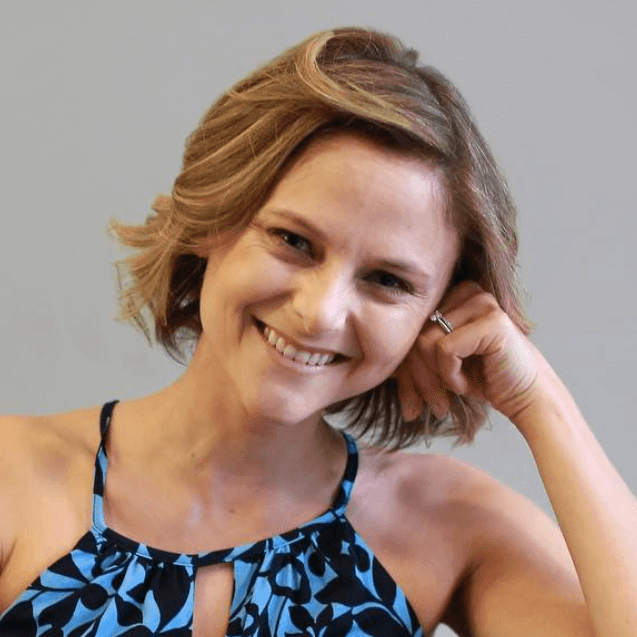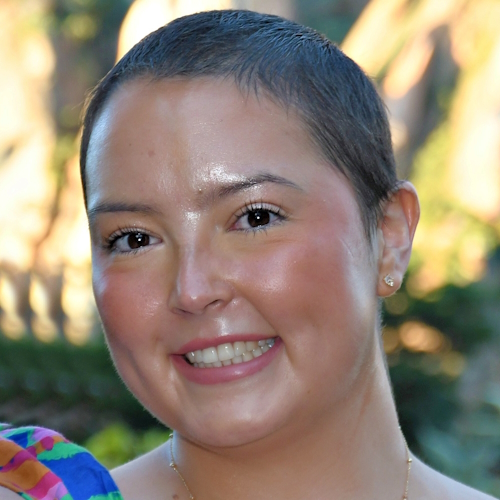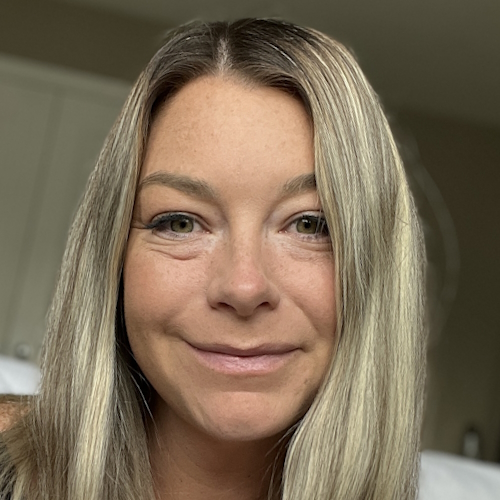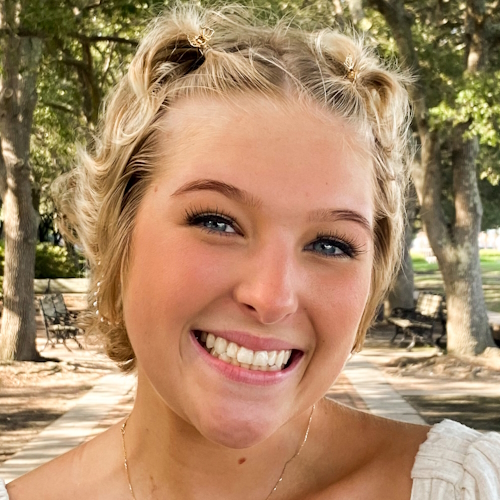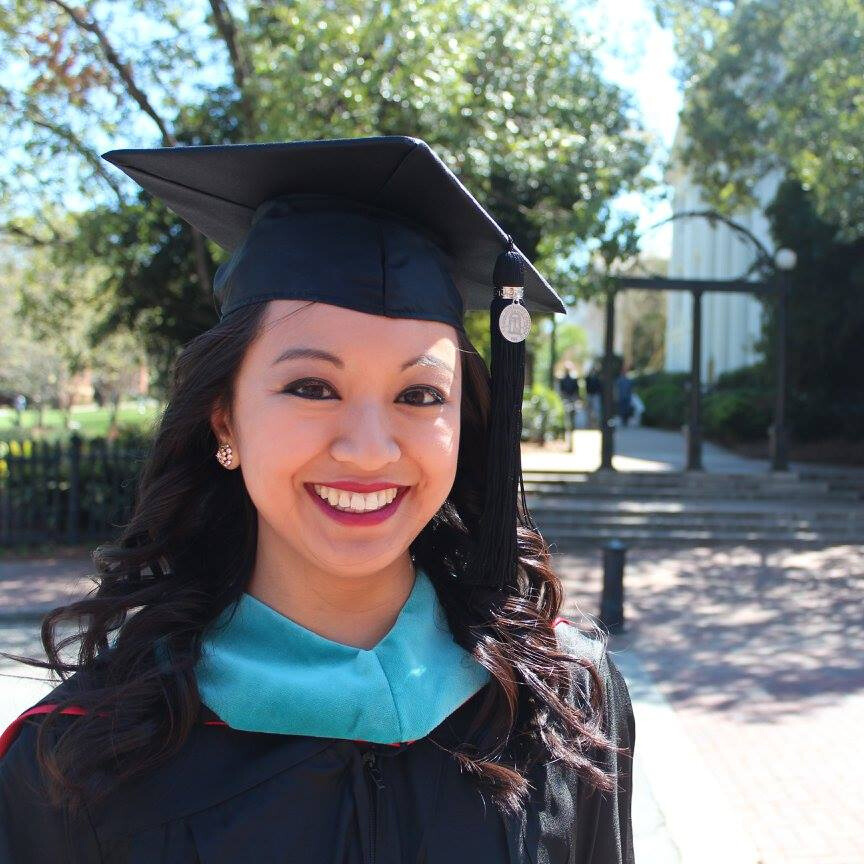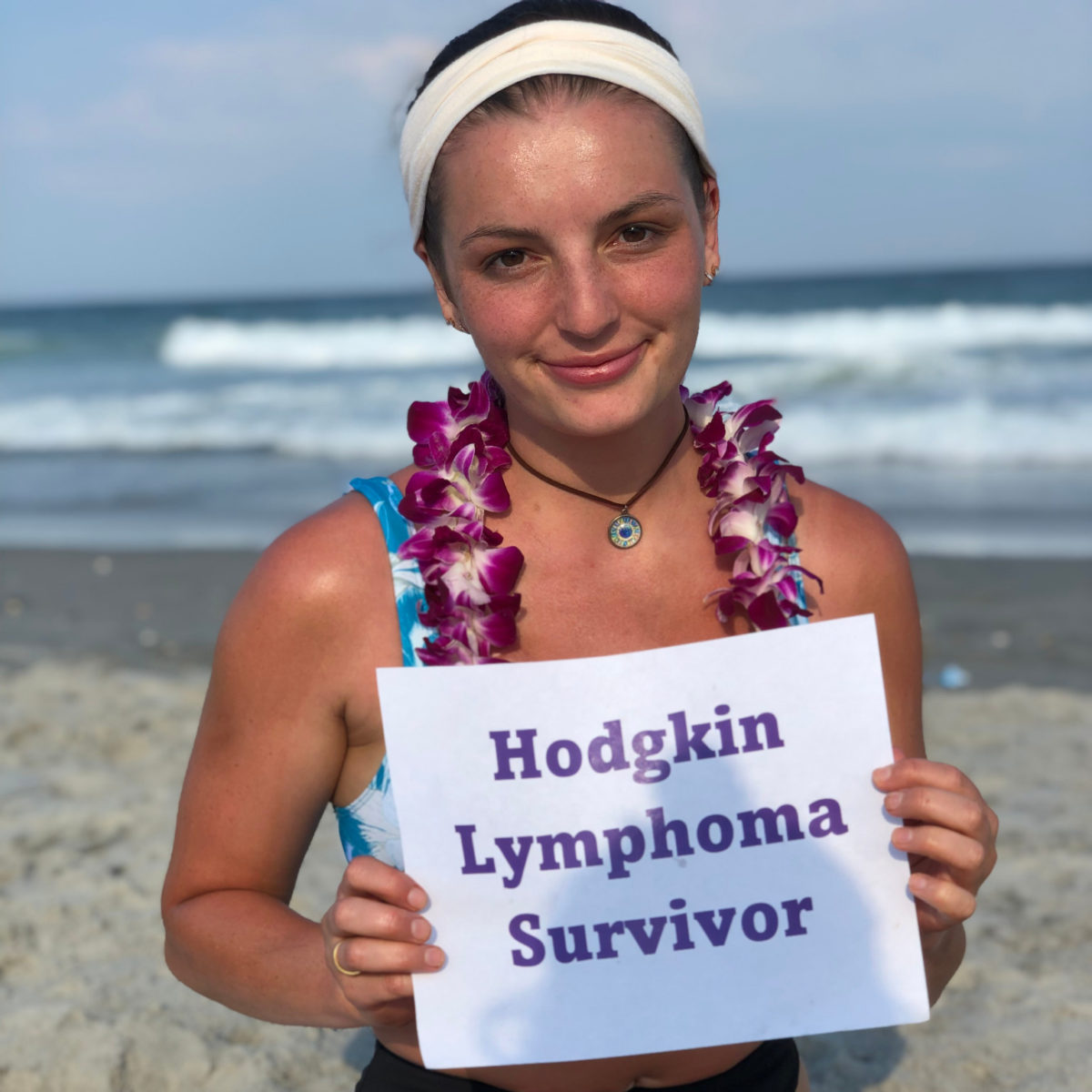Lauren’s Stage 2A Relapsed Nodular Sclerosis Hodgkin’s Lymphoma Story
Lauren describes getting diagnosed with stage 2A Hodgkin’s lymphoma at 23 years old, then relapsing after ABVD chemo.
She celebrated remission after undergoing radiation and a stem cell transplant, spotlighting issues like financial toxicity, deciding not to work during cancer treatment and self-advocacy as a patient.
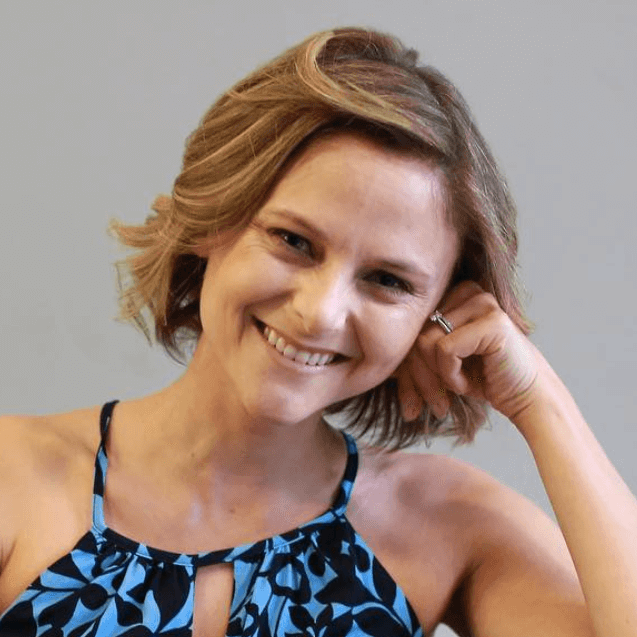
- Name: Lauren C.
- Diagnosis:
- Hodgkin’s Lymphoma
- Nodular Sclerosis
- Age when diagnosed: 23
- Staging: 2A
- 1st Symptoms:
- Itchy body
- Lump above collar bone
- Treatment:
- Chemotherapy
- 12 treatments of ABVD for 6 months
- Chemotherapy after relapse
- Preconditioning ICE chemotherapy
- Radiation
- Stem cell transplant
- Chemotherapy
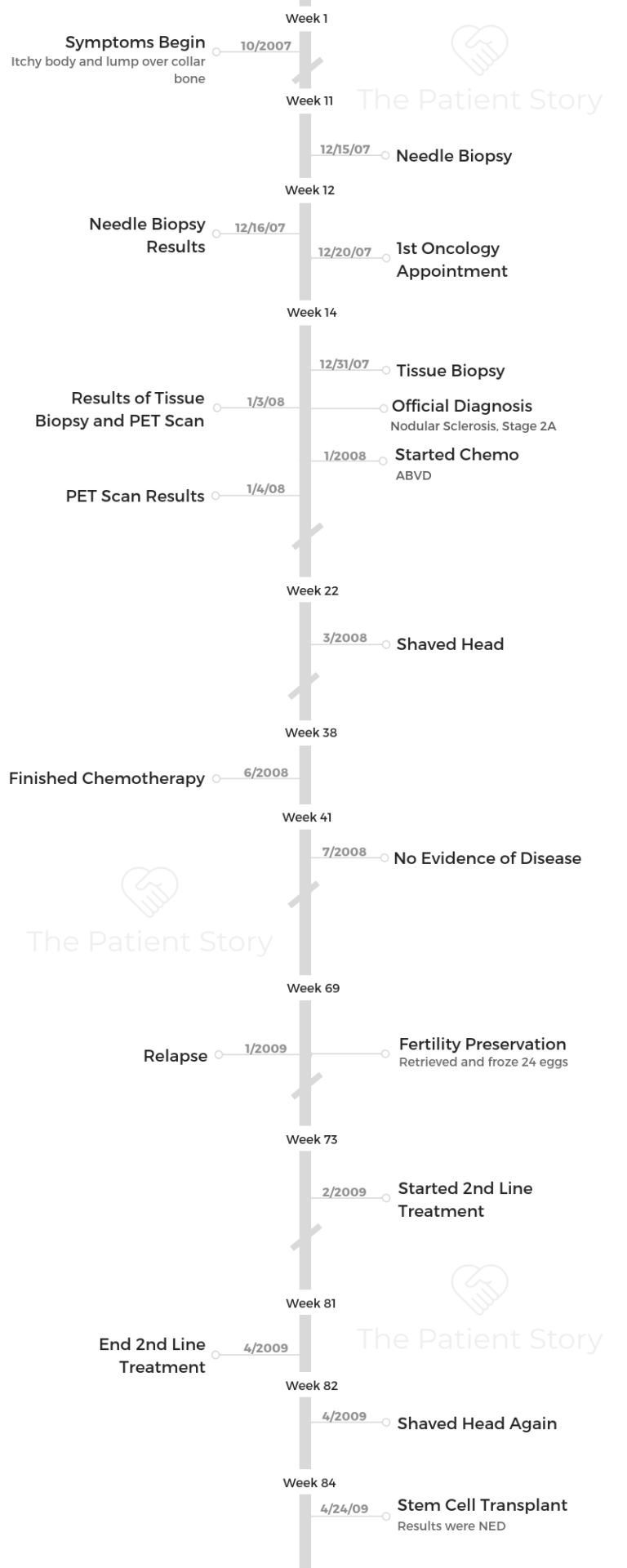
- Diagnosis
- Treatment
- Chemotherapy
- Relapse
- Second-Line Treatment
- Quality of Life
- How was your experience with hair loss?
- Were there any big surprises during treatment?
- Fertility preservation
- The toughest times during treatment
- What helped you the most during your low moments?
- Were there any moments where you had to advocate for yourself?
- How important is it to have caregivers?
- Recovering after treatment
- Were you able to ask other people for support?
- Did you work through treatment your second time around?
- Financial toxicity: paying for cancer treatment
- Was there anything you wish you had known about the financial process?
- What is the "new normal" following cancer?
- Message for other patients
This interview has been edited for clarity. This is not medical advice. Please consult with your healthcare provider for treatment decisions.
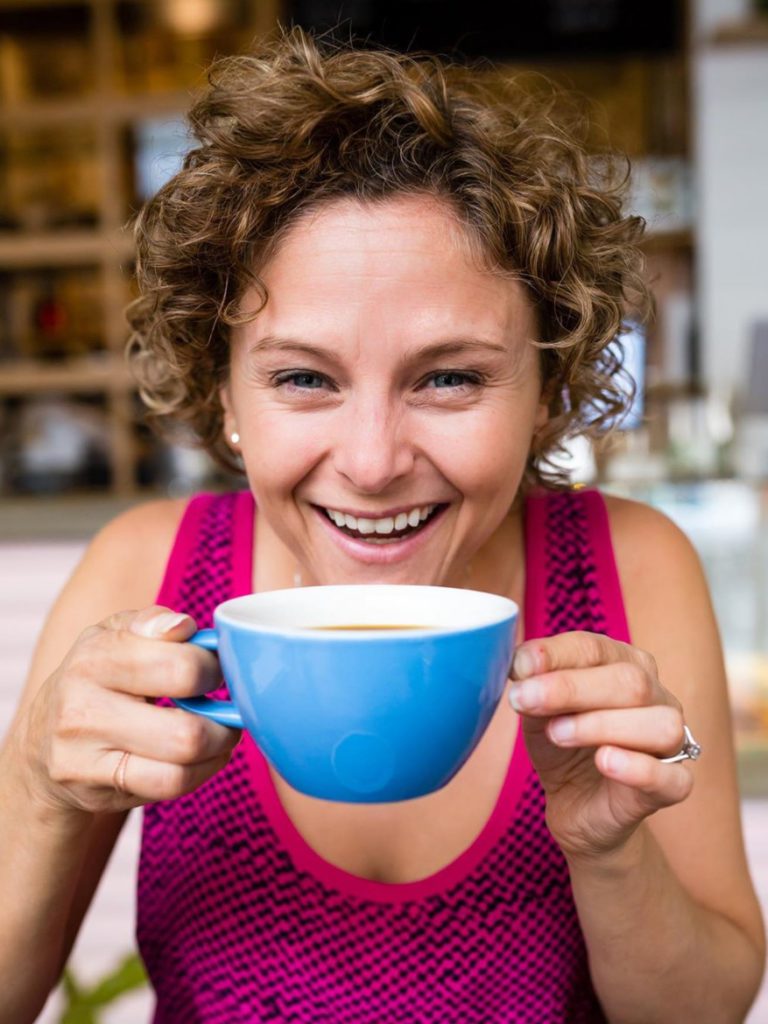
Advice that I always share with folks is just stay as positive as you can. Certainly there are going to be really hard days, but try to find the silver linings and the simple pleasures.
Just take one day at a time. As much as you can, stay in the present moment. Very much easier said than done, but it’ll help you stay grounded.
Lauren C.
Diagnosis
What were your 1st symptoms?
My first symptoms were itchy skin and an enlarged lymph node. My belly itched, my arms itched, everything itched so much it motivated me to go to a dermatologist’s office.
It was kind of unbearable and really distracted me at work. At the appointment, I mentioned I felt a lump over my collar bone that was getting bigger, so I asked her to check that out as well.
»MORE: Hodgkin’s lymphoma patients share common first symptoms
First visit to the doctor
When I was at the dermatologist, she just physically examined the enlarged lymph node. I didn’t even know that’s what it was at the time.
She had told me that she remembered the day in medical school when they had told her if someone young comes in with super itchy skin, not to discount them immediately or to think that it’s maybe just eczema.
Itchy skin is a symptom of Hodgkin’s lymphoma, especially in the younger population.
She recommended that I go see a general practitioner; she called me twice the following week to make sure that happened. I went to a general practitioner, and that’s where I got chest X-ray and blood work.
The chest X-ray right away showed a mass in the chest, as well as the blood work an elevated sed rate.
How long did it take to get the results back?
It was pretty much the next day. It was either 1 or 2 days.
Getting the diagnosis
From the general practitioner, I went to an ENT doctor, who then recommended that I go and see a head and neck surgeon, who did a needle biopsy.
It was from the needle biopsy that they were able to confirm the Hodgkin lymphoma. To stage it and know exactly what type — I had nodular sclerosis — they did a tissue biopsy.
It showed that the Reed-Sternberg cells were there, and that’s how they’re classified. That’s how I found out, from the needle biopsy and the tissue biopsy.
Processing the cancer diagnosis
I was just about a year and a half out of college, and I was totally devastated.
I had led a healthy lifestyle and just didn’t see it coming. I don’t think most people do, especially when you’re that young.
I remember my mom was with me at the head and neck surgeon’s office. I kind of collapsed in her arms and told her that I didn’t want to die. I think that really was my biggest fear, that I felt like I had so much life to live.
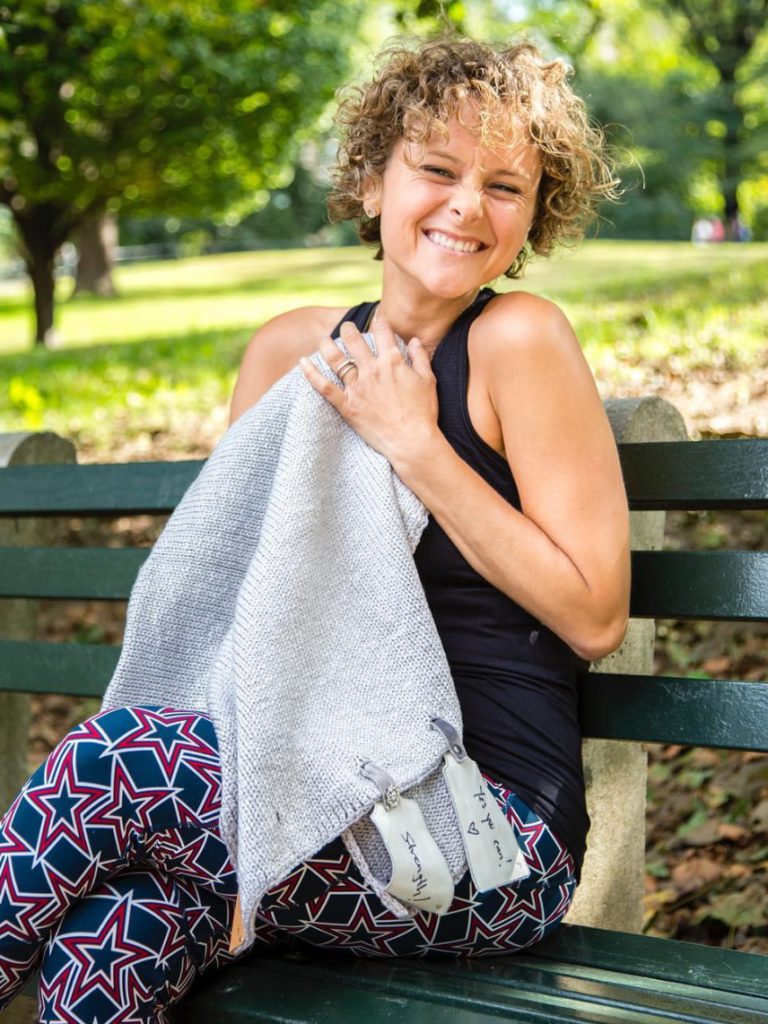
Did you get a second opinion?
I did. I went to Memorial Sloan Kettering to get a second opinion, and they recommended the same treatment protocol.
Luckily, it’s just pretty standard course of treatment that people recommend at least at that time. So 6 months of chemotherapy, 12 treatments of ABVD chemotherapy.
At the time, Memorial Sloan Kettering didn’t take my insurance, so I went to a private oncologist who had been there for 17 years and had left somewhat recently to start his own practice. I felt really grateful to be somewhere where I was in really good hands.
Treatment
Did you get your treatment through your private oncologist?
I did. I feel so grateful for that because he was the one who administered all my chemotherapy, which is very rare.
Usually it’s a chemo nurse, but he was the one who did all my treatments. I would go get chemotherapy and then go to work after.
Treatment schedule
The first time was the 6 months of chemotherapy, 12 treatments of ABVD, and that was from January through June of 2008. I was luckily able to still work full time.
I would get my chemo every other week on Thursday mornings, and then I’d be off to work. I would take every other Monday off just because I was on the steroid high, and then it would come crashing down.
I was able to work, so I felt grateful for that.
Was there anything you wish you had known at this point?
I think the biggest thing was that I wanted to know I wasn’t alone. That was one of my first questions: Who can I talk to, and who’s been through this?
Chemotherapy
How was ABVD chemotherapy?
With the chemotherapy, I definitely had nausea and fatigue. I lost my hair. Those were the biggest ones. It kind of impacted my day-to-day.
Luckily, I was able to still work, but looking back, socially there were different things I did. I had just moved into New York with 2 roommates, and I was so excited to take on the city and enjoy all that it has to offer. At the time I had to rest a lot, so it impacted me in that way.
How did you deal with the side effects?
Just trying to be patient and kind to myself.
I surrounded myself with people who were really positive. It was hard, though, especially losing my hair.
I was pretty self conscious about that and just wanted things to go back to how they were before.
I felt like I was missing out, but I dealt with it by surrounding myself with really good people — friends, family.
Through this experience, the power of community was shown to me in so many different ways.
Relapse
What happened after your first round of treatment?
I was declared in remission that summer. I was in remission for 6 months.
I trained for my first half marathon. A few friends of mine decided to fundraise for Leukemia and Lymphoma Society and run a full marathon. They inspired me to run a half marathon. I signed up for a half marathon and completed it.
The weekend of the race, I actually felt the lump on my collar come back. I ran the Disney World half marathon, and I had a huge group of friends that flew down for it. It was so special.
But that weekend I was pretty sure the cancer had returned, and a PET scan confirmed it the following week.
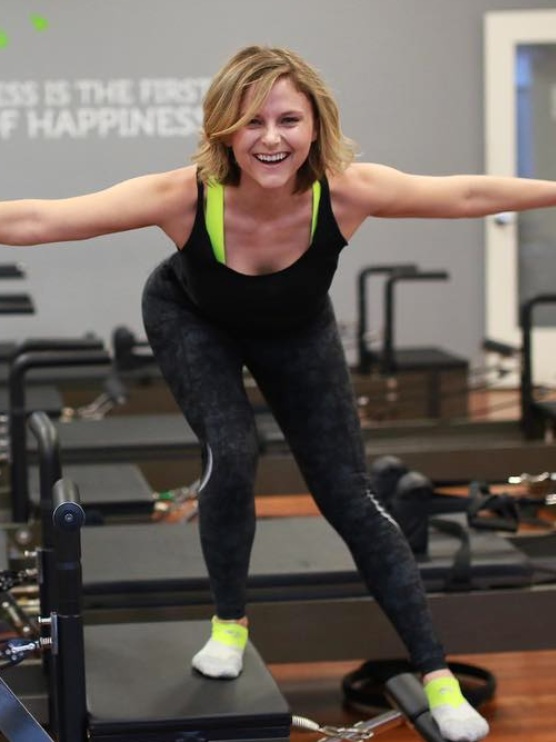
When I learned that I relapsed — kind of crazy enough, I had started working at Memorial Sloan Kettering Cancer Center in the development office in fundraising and event planning. I had just started a new role there 3 months prior, and I actually never even mentioned I had cancer.
During my interview, I wore a wig. I wanted to be hired for myself, my skills and talent. At this time of year, I also didn’t think it would come back.
It’s not all that common to relapse.
It happens, certainly, but I thought everything was behind me. Unfortunately, it came back, and I had to leave work for 6 months because treatment the second time around was a lot more intense.
Processing the relapse
So devastated. My dad was with me, and I had always kept this little notebook where I took all my notes when I had different doctor’s appointments.
I turned the page of my book. I just wrote ‘Round 2,’ and I was ready to go.
There’s just no choice. I felt very grateful that I’m in one of the best cities for healthcare in the world — and the fact that I was actually working at Memorial Sloan Kettering as an employee and in the best hands possible, truly.
I was obviously devastated and so much more scared the second time, because the fact that it had come back was really scary. I tried to stay as positive as I could. There are certainly hard days and hard weeks.
Second-Line Treatment
What was your treatment the second time?
I had 2 preconditioning chemotherapies. They called it ICE. I had 2 rounds of those, so I was inpatient for 3 days each during that.
Then I had a scan and all was looking really good, so they were able to move forward with the protocol.
Describe the ICE chemo
I had 2 rounds of the preconditioning chemotherapy, ICE, and I was in the hospital for 3 days each for that. Then in the midst of my hospital stay, I started my stay during my second week of radiation.
It was more intense that second week. Then I started my 5 days of high-dose chemotherapy. That’s when you’re just on the chemotherapy continuously at a really high dose. Then you have a day of rest, and then they give you the stem cells back.
What were the chemo side effects?
High fevers, throat sores, lost my hair again and extreme fatigue.
The miracle of the day was getting out of bed and maybe showering, so I was really quite knocked down.
What was radiation like?
I had 2 weeks of radiation. It was tiring. Very quick. I have 6 radiation tattoos on me, 4 in the front and 1 on each side.
The process to get it set up is pretty elaborate and so specific. That’s why you have to have the tattoos, because it’s so targeted. It’s really quick. You’re in there for just a couple of minutes, and I went twice a day.
I was tired, but it was like a cumulative effect. Oftentimes, folks have radiation for 5 or 6 weeks, and that’s really pretty rigorous. But for me, it was just the 2 weeks, and there’s also the fact that it was not too far after the ICE chemotherapies.
Prep for stem cell transplant
I had my stem cells collected, and then I had 2 weeks of radiation, high-dose chemotherapy and then the stem cell transplant.
I was in isolation for almost 6 weeks in Memorial Sloan Kettering on M8, the transplant floor. Then I went back to work in August.
Describe the actual stem cell transplant
I had an autologous stem cell transplant, and that’s when they take the stem cells from your bone marrow. Stem cells are blood cells that haven’t decided what they want to be yet. They might be red blood cells, white blood cells or platelets. That is very important in a disease.
Luckily, my cancer was not in my bone marrow. Oftentimes, you will hear people need donors, and that’s an allogeneic stem cell transplant. Because the cancer was not in my bone marrow, I was able to have my own stem cells transplanted.
I had a collection over a couple days, and then from there they freeze them. When you hear the word “transplant,” you think of lung transplant or heart transplant ,and it sounds super scary.
All they did was through a chest catheter, where I had the chemotherapy coming in and any blood transfusions. That’s where the stem cell transplant happened.
They essentially had a vial of my stem cells, and they were pushed back in through that chest catheter.
How was your experience with the stem cell transplant?
Pretty uneventful, actually.
It was a monumental day. It’s considered my second birthday, and it’s the day you are given a second chance at life.
So it has a lot of meaning, certainly, but on the day of it was pretty uneventful. They brought them in on the ice, and there it was. In the stem cells went.
It was very quick, to be honest. It was a very quick procedure. I don’t even think you could call it a procedure.
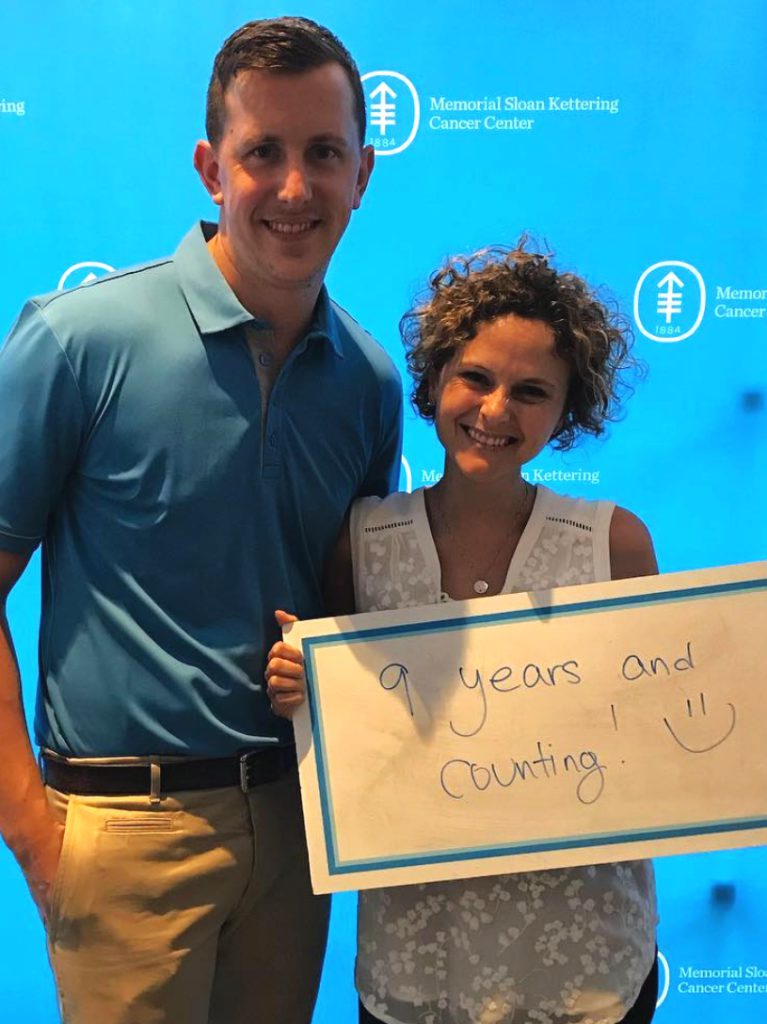
Quality of Life
How was your experience with hair loss?
It was expected, so I can’t say that I was super shocked that it happened. They had told me that I’d likely lose my hair. It was so hard just because you really look sick.
I felt like a shell of myself, but I did have a wig the first time around, and that definitely helped me feel a sense of normalcy.
I think the biggest thing was that I didn’t want to draw attention to myself or have people feel bad for me. I just wanted to continue on with life and keep bringing it back to that sense of normalcy.
My hair grew back fairly quickly. I just ended up rocking the hair that came back in. I never wore the wig again.
Were there any big surprises during treatment?
I was so surprised that the cancer came back. I felt like it was behind me, and I was excited to move on. That was definitely surprising. I was grateful that I was able to preserve my fertility.
That was something I went through right before treatment the second time. I was advised to freeze my eggs, so that was something I went ahead and did.
Those pieces of it were so important because a lot of times folks don’t have the time, or they’re not as informed. That was something that I would say surprised me because at 24, having a family was not on my radar yet. I also wasn’t dating anyone at the time, so it was kind of hard.
Fertility preservation
Emotionally, it was something I wasn’t even thinking of at all. I was a little frustrated in general that I had to even think about that.
Physically, you’re giving yourself all these hormone drugs to stimulate egg production. I didn’t feel all that great. I was staying hopeful, but I was able to retrieve 24 eggs, and they’re frozen still.
The toughest times during treatment
When I was in the hospital, I struggled with high fevers. I could barely swallow; I couldn’t even swallow my own saliva [because] it was so painful.
I had severe throat sores, so I was on a PCA pump, patient control, and a pain pump. I would press the pain pump a lot, every 7 minutes. We would set a timer so I would get the most pain medicine that I could. It was a tough go there for sure.
When I had the transplant, they basically bring you to the brink of death. Your blood counts are at zero.
Then slowly they start to rebuild. I needed several blood transfusions during that time, too.
It just was so tough. My mom stayed with me almost every single night in the hospital, so she was my sidekick. I just got through it one day at a time.
I think just feeling so terrible that I wasn’t able to do much. Everyone knows when you’re sick, knocked out by the flu or whatever. It’s so debilitating. It’s hard to do your regular day-to-day thing, even your fun magical adventure things. That was really hard for me.
I’m a super active person. I love to squeeze the juice out of life every day, doing so many things. But I just did not physically have the energy at all.
I was physically and mentally so knocked out and exhausted.
What helped you the most during your low moments?
Community. My support system was amazing.
My family and my friends are the ones that really lifted me up. I remember the summer I was recovering from the transplant.
I don’t think you’re supposed to fly a couple months after the transplant, but I was able to get the okay from my doctor.
It was about 90 days. That was the biggest sort of milestone. You have another PET scan 90 days post transplant.
That’s also a very significant period of when potentially they can see the transplant not working, so those 90 days post transplant is a big milestone.
I remember I was visiting a friend. She’s in chiropractic school. I was so excited I could get on a plane and visit my girlfriend from college and just have a great weekend.
I think just being around people really lifts me up. I love music and reading, and those were things that really helped.
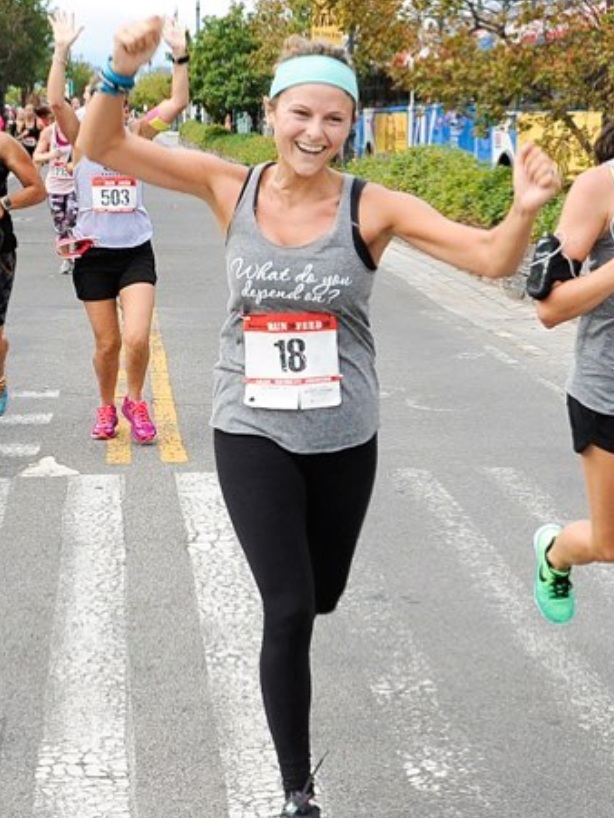
Were there any moments where you had to advocate for yourself?
In the sense of always asking questions. The treatment protocols can be really overwhelming, so just wanting to have a good sense of what was happening when, how, and little bit of the why. It’s a little bit hard for them to fully explain the why.
Nothing stands out really in particular, but I’d say just overall feeling empowered by asking questions, whether it be about timing or side effects from the treatments.
How important is it to have caregivers?
It’s so important to have caregivers. I think just going through something like this physically and mentally is really taxing. It’s overwhelming and information overload.
When you get in that doctor’s office, I always made sure I had someone with me. I had my list of questions and my awesome little notebook that I kept.
It was so important to have that extra set of ears and eyes on everything. They may fill in things you maybe forgot when you were talking, maybe what’s happened since last appointment, or ask questions that you might not think of right on the spot.
It’s just another person who is advocating for you and also caring for you.
Recovering after treatment
I celebrated my 25th birthday in the hospital, and I moved home. I grew up about an hour north of the city, so I had somewhere to go. I was close to the hospital for any issues and any follow-up appointments, which I did have a lot of.
I was able to recover at my parents’ house. It’s difficult when some folks might not have to that. You really have to rely on others, especially when you’re recovering from the stem cell transplant.
You’re really quite debilitated, and you can’t eat out. You can’t really be out in public because your immune system is so compromised. I had to get all my vaccinations again. It’s basically like you’re born again.
You really have to be mindful of infections. You really have to rely on other people to do a lot of things for you that you normally would be able to do for yourself.
Were you able to ask other people for support?
I had my sister, too, so she was wonderful. Actually, crazy enough that the time I was in the hospital, she was 9 months pregnant and gave birth to my first nephew. He luckily was born a couple days after I got out of the hospital.
I remember being like, “I need to be there for this. I can’t miss it.” I just felt so trapped. Luckily, I got out. I was probably not supposed to be in the hospital to see him, but I did short, quick visits.
We got stronger that summer together, and my sister was out on maternity leave; it was just such a special time.
My sister organized a blood drive for me. I mentioned that I needed blood transfusions, so blood cells and platelets, which are in that category.
She motivated folks to come to Memorial Sloan Kettering, their blood donor room, and donate blood for me. Even if it wasn’t necessarily used directly for me, it was used for other patients in the hospital, because they only have a certain shelf length. It never went to waste.
My friends’ ability to show up and support me, whether it be phone calls, emails or little packages. I remember at the time there was a program called “Spirit Jump.” It doesn’t exist anymore, but you submit your story or someone can submit on your behalf, and then it’s shared with this community.
I got letters and little gifts from people all over the country. They said, “We’re cheering you on! We can’t believe you just ran a half marathon! You’re such a rockstar, and you have more cheerleaders than you know!”
I got these really kind notes from all over the world, so that’s something that I’ve kept with me.
Any time someone that I know or friends of friends or family friends, if they’re going through a hard time, that’s one of the first things I ask. If there’s an address, I try to send a note of encouragement.
»VIDEO: Cancer patients share gift ideas for a loved one going through treatment
Did you work through treatment your second time around?
No. The second time, I left work for 6 months. I was out from February to August.
Financial toxicity: paying for cancer treatment
Luckily, the first time around, I had really good insurance coverage. The second time around as well, since I was an employee at Memorial Sloan Kettering, I was treated for free. That was huge.
During the fertility preservation, I was lucky enough to receive a grant from an organization called Fertile Hope. They have been since acquired by Livestrong, but that was a huge piece of my ability to cover the fertility preservation — the treatments and the collection.
Was there anything you wish you had known about the financial process?
I think that just in general with the healthcare system, you never know when you’re going to pay for anything. The claims get submitted, and you have no idea how much is really going to get covered.
It’s pretty nuts, because when do you go into somewhere not knowing what you’re going to pay? We go into restaurants, and you know what you’re paying for a meal. You go to a store and buy something, and you know how much it costs.
It’s so odd that we go into appointments and tests and different things, and we actually a lot of the time have no idea how much will be covered. I think that’s an issue with the healthcare system, and it’s really disappointing.
I don’t know if there’s much to know. Certainly, if you know you’re going for an office visit, you’re going to pay a copay, but I’m talking about different tests and stuff like that, which aren’t fully covered.
Sometimes you don’t even know what percentage will be covered, and then you get the bill in the mail. I think the lack of transparency and information sharing prior to moving forward with whatever is really strange, and I’m hopeful that maybe it’ll change over time.

What is the “new normal” following cancer?
It took a while to recover from the stem cell transplant. I was able to get back to work, but physically I was definitely pretty run down. I eased back into exercise and yoga and running. Running was such an important part of my life, so I really wanted to get back to that.
About a year after my transplant, I started classes at a studio, and I started taking barre classes. That’s like core strength classes. You use your whole body weight to create strength.
I fell in love with the method. It really changed my life so much that I started teaching the method. Fitness had become a huge part of my recovery, and I’ve run 7 half marathons and 2 full marathons fundraising cancer research.
I ran my 2 marathons with Fred’s Team. Fred’s Team is Memorial Sloan Kettering’s athletic endurance program, and you can actually have your funds allocated to any area of cancer research that you choose.
So I chose lymphoma one year, and I chose the survivorship clinic and program at the hospital.
My hope was just to really give back. I’ve been involved here for 9 years at the hospital. I work with patients and their families, listening, giving any guidance and insight that I can, and that’s been really meaningful. I also speak at nurse orientations and new employee orientations, sharing my story from a patient perspective.
That’s been so meaningful for me to just stay connected to everything that I had gone through and give people this beacon of hope.
My story is one of resiliency, and we face so many different life challenges. Mine happened to be cancer, but I think that any difficult challenge we face, we have the power and strength to overcome it.
Message for other patients
Advice that I always share with folks is just stay as positive as you can. Certainly there are going to be really hard days, but try to find the silver linings and the simple pleasures.
Just take one day at a time. As much as you can, stay in the present moment. Very much easier said than done, but it’ll help you stay grounded.
Surround yourself with people who are positive, who lift you up and who are supportive.
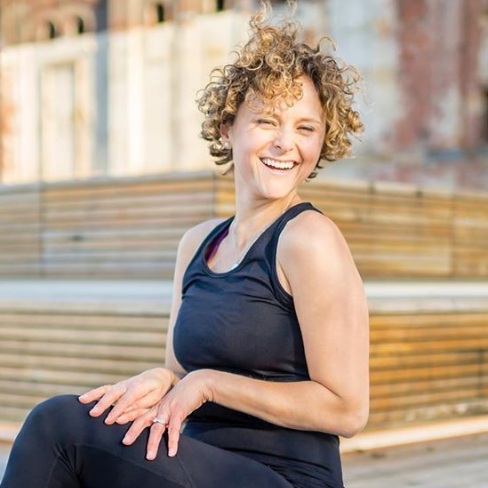
Inspired by Lauren's story?
Share your story, too!
Hodgkin’s Lymphoma Stories
Jessica H., Hodgkin’s Lymphoma, Stage 2
Symptom: Recurring red lump on the leg (painful, swollen, hot to touch)
Treatment: Chemotherapy
Riley G., Hodgkin’s, Stage 4
Symptoms: • Severe back pain, night sweats, difficulty breathing after alcohol consumption, low energy, intense itching
Treatment: Chemotherapy (ABVD)
Amanda P., Hodgkin’s, Stage 4
Symptoms: Intense itching (no rash), bruising from scratching, fever, swollen lymph node near the hip, severe fatigue, back pain, pallor
Treatments: Chemotherapy (A+AVD), Neulasta
